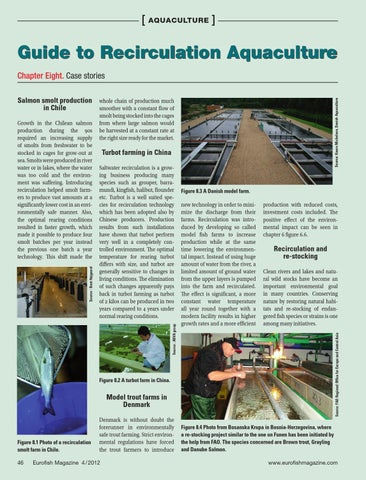[ AQUACULTURE ]
Guide to Recirculation Aquaculture Chapter Eight. Case stories
smolt being stocked into the cages from where large salmon would be harvested at a constant rate at the right size ready for the market.
Turbot farming in China
Figure 8.3 a Danish model farm.
new technology in order to minimize the discharge from their farms. Recirculation was introduced by developing so called model fish farms to increase production while at the same time lowering the environmental impact. Instead of using huge amount of water from the river, a limited amount of ground water from the upper layers is pumped into the farm and recirculated. The effect is significant, a more constant water temperature all year round together with a modern facility results in higher growth rates and a more efficient
production with reduced costs, investment costs included. The positive effect of the environmental impact can be seen in chapter 6 figure 6.6.
Recirculation and re-stocking Clean rivers and lakes and natural wild stocks have become an important environmental goal in many countries. Conserving nature by restoring natural habitats and re-stocking of endangered fish species or strains is one among many initiatives. Source: Fao Regional office for Europe and Central asia
Saltwater recirculation is a growing business producing many species such as grouper, barramundi, kingfish, halibut, flounder etc. Turbot is a well suited species for recirculation technology which has been adopted also by Chinese producers. Production results from such installations have shown that turbot perform very well in a completely controlled environment. The optimal temperature for rearing turbot differs with size, and turbot are generally sensitive to changes in living conditions. The elimination of such changes apparently pays back in turbot farming as turbot of 2 kilos can be produced in two years compared to 4 years under normal rearing conditions. Source : aKVa group
Source : bent Højgaard
Growth in the Chilean salmon production during the 90s required an increasing supply of smolts from freshwater to be stocked in cages for grow-out at sea. Smolts were produced in river water or in lakes, where the water was too cold and the environment was suffering. Introducing recirculation helped smolt farmers to produce vast amounts at a significantly lower cost in an environmentally safe manner. Also, the optimal rearing conditions resulted in faster growth, which made it possible to produce four smolt batches per year instead the previous one batch a year technology. This shift made the
Source: Kaare Michelsen, Danish aquaculture
Salmon smolt production whole chain of production much in Chile smoother with a constant flow of
Figure 8.2 a turbot farm in China.
Model trout farms in Denmark
Figure 8.1 Photo of a recirculation smolt farm in Chile. 46
Denmark is without doubt the forerunner in environmentally safe trout farming. Strict environmental regulations have forced the trout farmers to introduce
Eurofish Magazine 4 / 2012
09_Aquaculture.indd 46
Figure 8.4 Photo from bosanska Krupa in bosnia-Herzegovina, where a re-stocking project similar to the one on Funen has been initiated by the help from Fao. The species concerned are brown trout, Grayling and Danube Salmon. www.eurofishmagazine.com
14/07/12 6:41 PM
